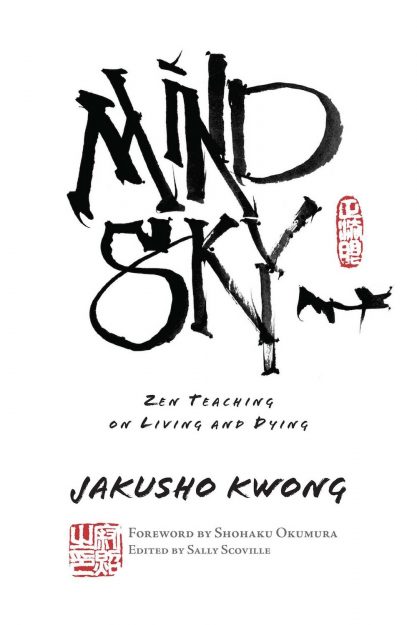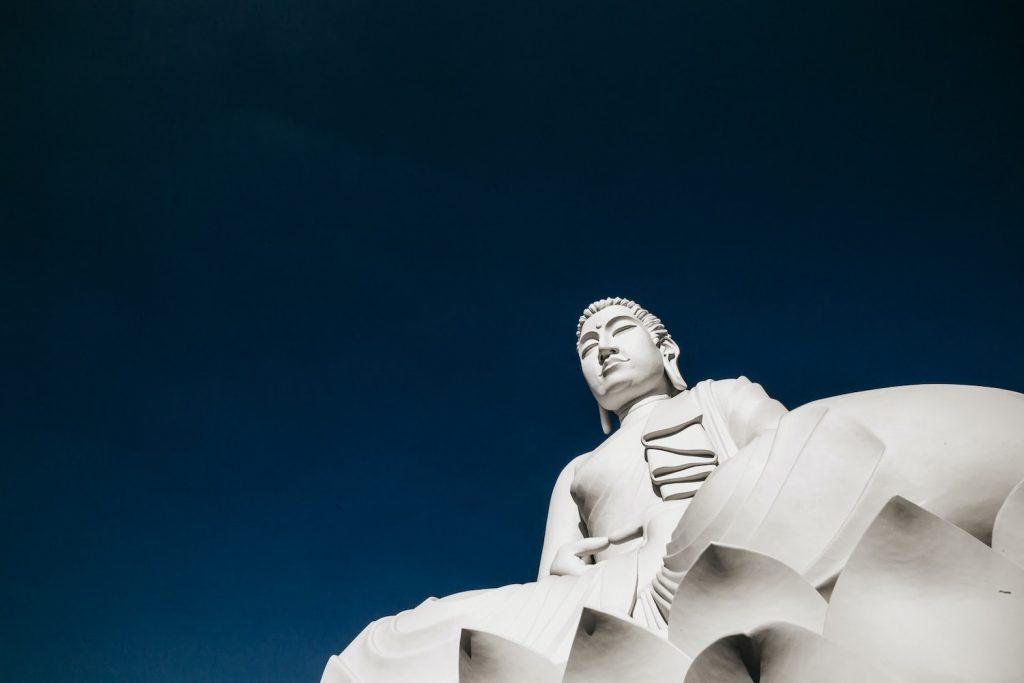People often ask me about the distinction between Zen and mindfulness meditation. Zen practice—zazen meditation—may seem difficult and intimidating compared to mindfulness meditation. But put simply, it goes beyond the samadhi of mindfulness. In zazen, samadhi eventually leads to shikantaza—which means “just sitting.” Shikantaza is objectless meditation, in which we don’t concentrate on any object or goal, or expect any gain. We let go of thoughts. We are just sitting. . .
The primary focus of Zen practice is on sitting meditation—zazen. The kanji for zazen—座禅—shows two people sitting together on the ground. Za means “to sit” and zen simply means “meditation.” You can start sitting zazen at any age, but it is easier when you’re young and your body is flexible enough to sit in the lotus posture or cross-legged. If you have physical difficulties, of course you can sit in a chair.
A while ago a new student here [at the Sonoma Mountain Zen Center] told me, “Coming here to practice didn’t change my life. I just discovered what I already have.” This is the essential point. Each one of you already has what’s needed, but you do not realize it. I don’t know how long it takes to feel confident about our fundamental buddhanature, which is present right now. It’s not something you learn in school. You were born with it, fully developed, waiting to be realized. It is with you perpetually. As Suzuki-roshi said, “Everywhere you go, it’s always with you. It hasn’t left you for one minute.” But it seems that of all the species in the animal kingdom, only human beings fail to know this intuitively.
In meditation, it’s common to try to stop the mind’s activity entirely. That is actually the worst thing to do, because the result is invariably more activity. There’s nothing wrong with coming to meditation in order to quiet the mind, but since trying to stop the mind during meditation is impossible, what you need to do is let it pervade your whole body. This is because any active mind, whether preoccupied or disturbed, keeps telling you that you should be doing something. As your mind becomes busier it seems to set off an alarm, insisting that you pay attention. What you can do is to focus not with the brain-mind but with the body-mind.
In zazen, this attention to the body-mind eventually leads to an expanded awareness both of your own body and of the entire universe in which it exists. When mind truly permeates the body, you are concentrating on neither the inside nor the outside, nor in between. Rather, your concentration permeates your whole body. This means that the mind itself is fundamentally uninterrupted and capable of reaching through the entire universe. I think of zazen as slowly unwinding a ball of yarn with your full attention. If you do it impatiently, you’ll leave plenty of knots, and you’ll still have to untangle them carefully. In fact, you’ll meet all kinds of delusions through the unwinding process of zazen. No other way is so direct. It’s the most reliable method for confronting and working with what’s in your mind—the chatter, the projections, the fears. Since your mind is with you wherever you go, you need to sit down and start unwinding your ball of yarn.
It’s your life. No one can do this for you. Your teacher can set you in a particular direction, but you have to go on the path alone. If you decide to do zazen every day, then do it every day; if once a week, do it once a week! Try to sit at the same time every day, so that it forms a consistent rhythm in your life. Don’t begin missing it. This discipline may be hard if you’re alone; it helps to sit with others—in a community, a sangha.
The greatest challenge in zazen is your conceptualizing mind, which accelerates endlessly, from the moment you get up to when you go to sleep. Often there’s hardly an instant in twenty-four hours when you’re not furiously thinking. Unless you have a way to appease the incessant chatter, you can end up being completely driven to distraction by delusive thoughts.
You don’t escape from your delusions in zazen. Instead, you look straight at them, since you have to work with them. This is the paradox. You never enter a promised paradise in which there will be no delusion. But all your delusions are workable. If they weren’t, I think we’d all go mad. Still, you need to work with them in the right way. As Zen students, you should be totally committed to sitting—as [13th-century Zen master Eihei] Dogen, [the founder of the Soto School of Japanese Zen], put it, sitting wholeheartedly.
When you’re wholeheartedly practicing zazen, you’re not “doing” zazen. You’re not doing anything, because the thinking mind has ceased. You’re not “doing” at all anymore. That’s what “wholehearted” means. There’s a big difference right here. Even if your wholeheartedness lasts for a single second, this is the cessation of thought. You’re not doing zazen; zazen is doing you. Zazen is doing zazen. . .
The twelfth-century Zen master Wanshi (Ch. Hongzhi Zhengjue) used the term silent illumination for what happens in “just sitting.” Although it may sound inactive, silent illumination has great energy. You’re not a lump of flesh. You’re silently illuminating, emanating pure, fiery energy, which consumes the deeply rooted greed, anger, and ignorance keeping you separated from reality. Once these delusions are extinguished there is no obstacle to seeing the basic goodness that is already there within you.
In his verse, “The Acupuncture Needle of Zazen,” Wanshi speaks of “illuminating without encountering objects.” We may assume that every object we encounter is delusion, but Wanshi’s phrase implies that there is no object. To understand this, we need to ask: What is the essence of this object? What is it that we see? Who is it that sees? We need to investigate what’s behind the object, and behind that, and further behind, until there is no behind. Wanshi also says that we must do so without grasping, without reaching toward something outside ourselves. We don’t need to touch what we already have. That effort would be extra. This dynamic awareness is present, in our knowing without touching, without engaging in discriminating thinking. Dualism is dissolved. This, rather than any suppression of thought, is prajna awareness.
Although it may be difficult to perceive, “illuminating without encountering objects” is exactly what occurs in true meditation practice. Illuminating without encountering objects: once you become thoroughly aware of this in zazen, there’s no need to come to a Zen center. It’s no longer a matter of seeking assurance, but of manifesting your own wisdom and transmitting it to others. I’m really just selling water by the river. Wanshi comments: “If you think you have cut off the illusory mind or the deluded mind instead of clarifying how the delusion mind melts, delusion mind will come up again as though you had not cut the root of a blade of grass.” Wanshi is saying that rather than trying to cut off delusory mind, you should come to see how delusions vanish in the light of prajna awareness. Otherwise your delusory mind will come up again and again, as though you’d cut the stem of a plant but let the root survive. Wanshi’s objectless illumination doesn’t deny the objective reality of your experiences, but allows them to merge naturally into unified awareness, into prajna. . .
In his “Song of the Grass-Roof Hermitage,” [eighth-century Zen master ] Sekito Kisen tells us to turn around the light—to turn awareness around to shine within, and then just return. Wanshi urges practitioners to take the backward step, and stand directly in the middle of the circle where light issues forth. Wanshi and Sekito Kisen are both predecessors of Dogen. For them, it’s not an assumption but reality that we are each in the circle, in the presence of light, whether we see it or not.
If you allow everything to drop away, realization may occur. It is usually not earth-shattering at all, however, just great simplicity in turning your light to shine within. You take your mind just as it is, in whatever state it’s in, and focus on it—shine your awareness on it. It’s mind on mind. That’s the backward step. This practice takes time, so you shouldn’t get discouraged if you do not get it right away. It requires discipline and training to turn your light to shine within. Direct your attention and closely observe your own awareness. Ask yourself, where is my awareness, right now?
You can’t study Zen just by reading and thinking about it; intellectual understanding is not Zen. So many books have been written on Zen Buddhism, such a prolific body of literature about something you can’t even talk about! If you read them all, it would consume your whole life, and you’d still miss the point.
So stop your practice based on “pursuing words and following after speech,” as Dogen puts it. Don’t let yourself become attached to words. Words just point the way. Learn to take the backward step that turns your light inward, illuminating your true self. Then, without a doubt, your original face, your original mind, will appear.
♦

Adapted from Mind Sky: Zen Teaching on Living and Dying, by Jakusho Kwong-roshi, and reprinted with permission from Wisdom Publications.
Thank you for subscribing to Tricycle! As a nonprofit, we depend on readers like you to keep Buddhist teachings and practices widely available.
